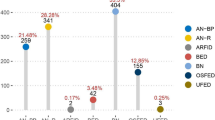Abstract
Objective:
To describe the personal and family antecedents and clinical characteristics of patients with eating disorders (EDs) in a population of the south of Spain; to analyse the influence of lifestyles, family functioning, socioeconomic status (SES), and psychological characteristics in these processes.
Design:
A university-based case–control study.
Setting:
University Hospital (Andalusia, Spain).
Subjects:
A total of 120 patients with EDs and 240 controls.
Interventions:
SCOFF, EDI, APGAR family, and SES questionnaires.
Results:
In all, 67.5% of patients presented anorexia (AN), 15% bulimia (BN), and 17.5% mixed forms. EDs emerged at around 18–20 y (95% CI 17.9–19.8). Factors associated with EDs are psychiatric conditions (depression OR: 4.16, anxiety OR: 4.59), more frequent use of medication (OR: 2.26), dietary fibre (OR: 2.59), and laxatives (OR: 3.47). Toxics consumption, sport activity, SES, and family antecedents of pathology are not associated with EDs. An inverse relationship was found between family functioning and the scores in various subscales of the EDI.
Conclusions:
Eating disorders in Andalusia (Spain) are influenced significantly more by psychological, family, and cultural factors than by social factors.
This is a preview of subscription content, access via your institution
Access options
Subscribe to this journal
Receive 12 print issues and online access
$259.00 per year
only $21.58 per issue
Buy this article
- Purchase on Springer Link
- Instant access to full article PDF
Prices may be subject to local taxes which are calculated during checkout

Similar content being viewed by others
References
Bellodi L, Cavallini MC, Bertelli S, Chiapparino D, Riboldi C & Smarald E (2001): Morbidity risk for obsessive-compulsive spectrum disorders in first degree relatives of patients with eating disorders. Am. J. Psychiatry 158, 563–569.
Broadhead WE, Kaplan BH, James SA, Wagner EH, Schoenbach VJ, Grimson R, Heyden S, Tibblin G & Gehlbach SH (1983): The epidemiologic evidence for a relationship between social support and health. Am. J. Epidemiol. 117, 521–537.
Byrne S & McLean N (2001): Eating disorders in athletes: a review of the literature. J. Sci. Med. Sport. 4, 145–159.
Dare C & Key A (1999): Family functioning and adolescent anorexia nervosa. Br. J. Psychiatry 175, 89–90.
Fairburn CG, Cooper Z, Doll HA & Welch SL (1999): Risk factors for anorexia nervosa: three integrated case-control comparisons. Arch. Gen. Psychiatry 56, 468–476.
Garner D, Olmstead M & Polivy J (1983): Development and validation of multidimensional eating disorder inventory for anorexia nervosa and bulimia. Int. Eat. Disord. 2, 15–34.
Laliberte M, Boland FJ & Leichner P (1999): Family climates: family factors specific to disturbed eating and bulimia nervosa. J. Clin. Psychol. 55, 1021–1040.
Lewinsohn PM, Striegel Moore R & Seeley JR (2000): Epidemiology and natural course of eating disorders in young women from adolescence to young adulthood. J. Am. Acad. Child. Adolesc. Psychiatry 39, 1284–1292.
Lilenfeld LR, Stein D, Bulik CM, Strober M, Plotnicov K, Pollice C, Rao R, Merikangas KR, Nagy L & Kaye WH (2000): Personality traits among currently eating disordered, recovered and never ill first-degree female relatives of bulimic and control women. Psychol. Med. 30, 1399–1410.
McClelland L & Crisp A (2001): Anorexia nervosa and social class. Int. J. Eat. Disord. 29, 150–156.
Morgan JF, Lacey JH & Reid F (1999a): Anorexia nervosa: changes in sexuality during weight restoration. Psychosom. Med. 61, 541–545.
Morgan JF, Reid DF & Lacey JH (1999b): The Scoff questionnaire: assessment of a new screening tool for eating disorders. BMJ 319, 1467–1468.
Patrick L (2002): Eating disorders: a review of the literature with emphasis on medical complications and clinical nutrition. Altern. Med. Rev. 7, 184–202.
Pérez Gaspar M, Gual P, de Irala Estevez J, Martínez Gonzále MA, Lahortiga F & Cervera S (2000): Prevalencia de trastornos de la conducta alimentaria en las adolescentes navarras. Med. Clin. 114, 481–486.
Pla C & Toro J (1999): Anorexia nervosa in a Spanish adolescent sample: an 8 year longitudinal study. Acta. Psychiatr. Scand. 100, 441–446.
Rodríguez-Martín A, Martinez Nieto JM, Ruiz Jimenez MA, Novalbos Ruiz JP, Vazquez MC, Fernandez YC, Gomez MA & Fernandez CC (1999): Unhealthy eating behaviour in adolescents. Eur. J. Epidemiol. 15, 643–648.
Rogers L, Resnick MD, Mitchell JE & Blum RW (1997): The relationship between socioeconomic status and eating-disordered behaviors in a community sample of adolescent girls. Int. J. Eat. Disord. 22, 15–23.
Smilkstein G (1978): The family APGAR: a proposal for a family function test and its use by physicians. J. Fam. Pract. 6, 1231–1239.
Westermeyer J & Specker S (1999): Social resources and social function in comorbid eating and substance disorder: a matched-pairs study. Am. J. Addict. 8, 332–336.
Author information
Authors and Affiliations
Corresponding author
Additional information
Guarantors: A Rodríguez Martín and JP Novalbos Ruiz.
Contributors: All authors were responsible for planning the study. All authors contributed to statistical analysis and writing of the paper.
Rights and permissions
About this article
Cite this article
Rodríguez Martín, A., Novalbos Ruiz, J., Martinez Nieto, J. et al. Characteristics of eating disorders in a university hospital-based Spanish population. Eur J Clin Nutr 59, 459–462 (2005). https://doi.org/10.1038/sj.ejcn.1602095
Received:
Revised:
Accepted:
Published:
Issue Date:
DOI: https://doi.org/10.1038/sj.ejcn.1602095


